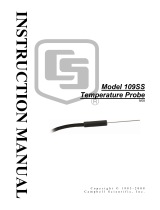
247 CONDUCTIVITY AND TEMPERATURE PROBES
2
2.2 EC SENSOR
Electrodes: Passivated 316 SS with DC
isolation capacitors.
Cell constant: Individually calibrated. The cell
constant (K
c
) is found on a label near the
termination of the cable.
Temp. Range of Use: Above freezing to 50°C.
EC Range: Approx. 0.005 to 7.5 mS cm
-1
.
Accuracy: in KCl and Na
2
SO
4
, NaHCO
3
, and
NaCl standards at 25°C:
±5% of reading 0.44 to 7.0 mS cm
-1
.
±10% of reading 0.005 to 0.44 mS cm
-1
.
2.3 TEMPERATURE SENSOR
Thermistor: Betatherm 100K6A1.
Range: 0°C to 50°C.
Accuracy: Error ±0.4°C (See Section 8.2).
3. INSTALLATION
CAUTION: Rapid heating and cooling of the
probe, such as leaving it in the sun and then
submersing it in a cold stream, may cause
irreparable damage.
3.1 SITE SELECTION
The EC sensor measures the EC of water
inside the epoxy tube, so detection of rapid
changes in EC requires that the probe be
flushed continuously. This is easy to
accommodate in a flowing stream by simply
orienting the sensor parallel to the direction of
flow. In stilling wells and ground wells,
however, diffusion rate of ions limits the
response time.
3.2 MOUNTING
The epoxy housing and sensor cable are made
of water impervious, durable materials. Care
should be taken, however, to mount the probe
where contact with abrasives and moving
objects will be avoided. Weighting to facilitate
installation in wells is provided by the stainless
steel sleeve on the 247W-L. Strain on cables
can be minimized by using a split mesh strain
relief sleeve on the cable, which is
recommended for cables over 100 ft. The
strain relief sleeve is available from Campbell
Scientific as part number 7421.
4. WIRING
The 247s manufactured after January 1, 1994
are connected to a Campbell Scientific
datalogger as illustrated in Figure 4-1.
NOTE: The excitation channel used for EC
must be separate from the one used for
temperature or measurement errors will result.
To make previous versions of the 247 (those
without an orange lead) compatible with the
information in this manual, connect existing
wires as shown in Figure 4-1. Attach one end
of a short piece of insulated wire to the
excitation channel servicing the black lead and
the other end to the H side of the selected
differential channel (this wire acts as the absent
orange lead). If your probe has a blue lead, it is
no longer needed. Tape the exposed portion to
avoid shorting the sensor.
5. PROGRAMMING
5.1 PROGRAMMING OVERVIEW
Typical datalogger programs to measure the
247 consist of four parts:
1. Measurement of EC and temperature
2. Correction of ionization errors in EC
measurements
3. Correction of temperature errors in EC
measurements
4. Output processing
All example programs may require modification
by the user to fit the specific application's wiring
and programming needs. Example programs in
this manual assume that the orange lead is
connected to 1H, the white to 1L, the red to 2H,
the green to E2, and the black to E1.


















